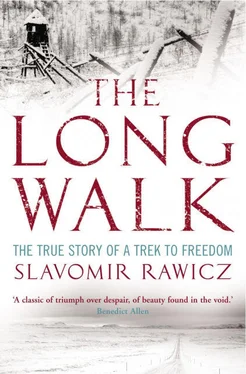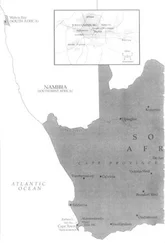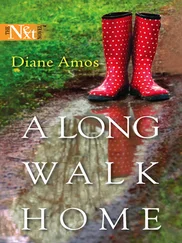Then the man, in his slow and gentle voice, said to Zaro, ‘Go with the man who brought you to me. He will take you to his house and look after you. Later I will join you and you shall talk again to me.’ He turned and spoke briefly to the Tibetan. We were led off, taken into a house and regaled with tea while a meal was in preparation.
The teacher walked in quietly. He entered without knocking — nobody seems to knock on doors in Tibet — and bowed all round. He sat with us and when the meal came ate with us. He produced a clasp knife attached to a plaited leather thong about his waist and, noting my interest, handed it to me. It was single-bladed, bone handled and the inscription on the steel showed it had been made in Germany. He did not tell me where he had obtained it.
Zaro tried to get from him where he had been educated and particularly where he had learned his little French but he cleverly allowed his attention to be distracted by his host, leaving the question hanging in the air. Zaro’s inquiries on this point were, in fact, never answered. The man interested me tremendously and I felt sure he had not lived the whole of his life in Tibet. The thought has since occurred to me that he might have spent some part of his time in French Indo-China.
With our habitual caution we did not tell him the origin of our journey but Zaro satisfied his curiosity on the manner of our entry into Tibet. He was genuinely impressed to learn that we had crossed the Gobi. He said he had not heard of anyone making the crossing without animals and without food supplies.
‘And where are you going now?’ he asked.
‘We are trying to reach India,’ said Zaro. It was pointless now to talk of a pilgrimage to Lhasa. We were off course.
The Tibetan householder interrupted politely to ask for a translation. The teacher answered and both men showed concern.
‘You should change your route,’ he advised us. ‘The weather will be bad in the mountains and you will suffer greatly. The best thing you can do is to go to Lhasa and join up with a caravan. You may have to wait a long time but you will find it worthwhile.’
Zaro said we would think over his counsel, but we all knew we were going on and that we should never enter Lhasa.
We asked the teacher to thank the Tibetan for the meal and for his kindness to us. The message was passed over. The Tibetan talked and the teacher said to us, ‘The man is pleased. He wishes your feet will preserve you and that you will not meet with any misfortune on your way. He says you will stay with him tonight and he will give you food for your journey tomorrow.’
We sat there talking until long after darkness. Through Zaro I asked a question on a subject that had been bothering me ever since I entered the house — that was the peculiar, acrid, faintly farmhouse smell in the place.
The teacher smiled and pointed to the stone floor, which appeared to have been given a hard, thick coat of brick-red paint. The smell, he explained, came from the floor. The smooth painted effect was achieved by house-proud Tibetans in this part with the use of a fine red dust mixed with animal urine.
Zaro had him work out the date for us. It was 23 December 1941.
We slept soundly on sheepskins spread on the coloured stone floor and the next morning were given food as we had been promised and sent on our way with good wishes for the success of our journey.
On Christmas Eve we sat up around a bright fire. The night was freezing and no one wanted to settle down to a chilled half-sleep. We talked about Christmases we had known, of the awful Christmas a year ago when we were slogging north to the timber camp. Paluchowicz, that tough, devout old Roman Catholic, surprised us all by suddenly starting to sing in his rusty, off-tune voice a Polish carol. He got through two verses; then, finding we were not going to join in, became silent.
After a little while he said, ‘Every Christmas since I was old enough to remember I have sung carols on Christmas Eve. So tonight I have sung a carol. It will be good for us, I know.’
The days were cold now, the nights colder. Snow-charged clouds hung menacingly over the distant, gaunt foothills of the Himalayas. In a poor hamlet of four stone-built shacks we stayed one night and the next morning spent several hours making warm mittens from the Circassian’s gift fleece.
There came one clear day when we saw the snow-capped, cloud-topped soaring hump of the Himalayas, deceptively near. We were, in fact, a long way off and were to find the intervening distance fraught with trial and hazard.
We tried desperately not to be caught on the heights after darkness, but there was nothing we could do about it when early one afternoon we were enveloped in a howling snowstorm. It would have been folly to push on through it. The snow was whipping into our eyes and it was difficult to see more than a few yards ahead. As we crept along looking for shelter the snow packed hard on our moccasins. We were on a normally steep descent and the slippery soles threatened us at every downward step with disaster.
Luck or Providence gave us a natural, cave-like windbreak between two great rocks lying at an acute angle. With us we carried one sack of wood and some dried animal droppings which we took turns in carrying and we set about lighting a fire. We almost gave up the job as time and again the glowing gubka failed to get the small dry twigs alight in this high, snow-laden wind. Zaro and I worked on the job for what must have been over an hour before we met success. Over the narrow opening at the junction of the two rocks we spread our sacks, pinning them down with the heaviest stones we could find and they were soon sagging with the weight of the snow. Then we jammed our sticks, rafter-fashion, under the sacks to take the strain.
By morning we were snowed in, but surprisingly cosy in our smoky little retreat. The worst of the storm was over and only small snow flurries under a watery sun greeted us when we dug our way out. The descent was perilous but we made it unscathed. It took us all day to get down from our high perch.
IESTIMATE the time to have been late January when we came to the great river, iced over from bank to bank. This must have been the broad Tibetan waterway flowing west to east across the southern part of the country to find its way through the mountain barrier into India as the mighty Brahmaputra. Winter had overtaken us and the night temperatures were well below zero. There were occasional heavy snowfalls, sleety rain, winds which whipped down off the tops of the hills with the chill of the heights in them. Bitter though the conditions, they had not the severity of the Siberian winter. But they were grim enough for us, underfed and weakened by nine long months of continuous foot travel. We crossed the river warily, Zaro, the lightest of us, leading to test the strength of the ice in the middle, where we feared it might not take our weight. There was no difficulty, however, until we reached the south bank, which was tall, steep and ice-coated. Kolemenos chipped steps out with the axe and we climbed up. We followed the river along westwards for a mile or so until we came to a point where the bank fell away, offering easy access to the water. Grouped here were three low stone huts and in front of them on a small sloping beach well back from the river edge half-a-dozen small boats lay keels upwards. Because of their high bows and sterns the boats were canted over, leaving space enough between the gunwales and the ground for a man to crawl under. I poked my head under and sniffed at the smell of long-dead fish. In the boat’s planks I could see fish scales.
In a bunch we moved over to the huts. Inside they were so low that Kolemenos had to bend his head to avoid touching the roof. The construction of the roof was interesting: bamboo lengths supported a covering of tightly-interlaced wattles, into which were woven twisted cords of animal hair, probably yak’s. The floors were dry enough to suggest that the roofs were reasonably watertight. The construction was of the crudest — three stone boxes with mats thrown over the top, with doorless slits for entrances. They contained some old nets, some odd lengths of bamboo poles and a few short, big-diameter cylinders of wood, heavily rubbed and scored, which were obviously used as rollers upon which the boats were pushed to the water and launched.
Читать дальше






![Джеффри Арчер - The Short, the Long and the Tall [С иллюстрациями]](/books/388600/dzheffri-archer-the-short-the-long-and-the-tall-s-thumb.webp)





